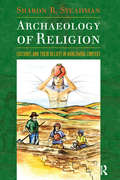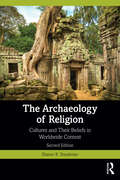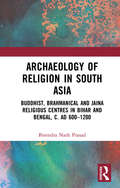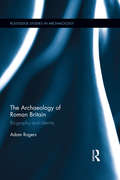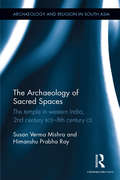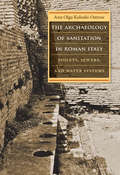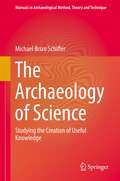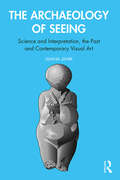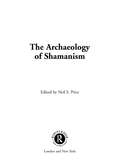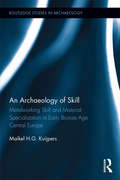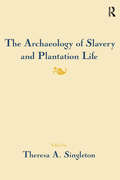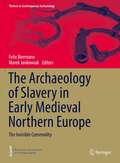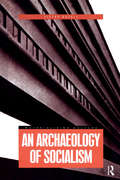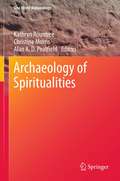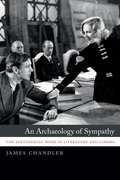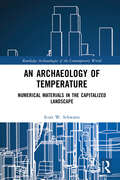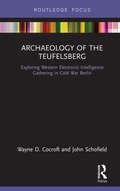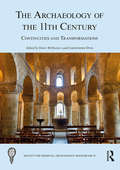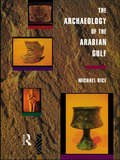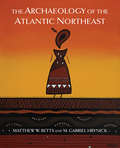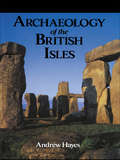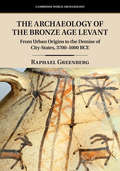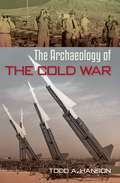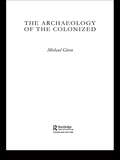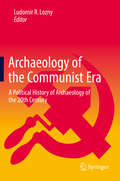- Table View
- List View
Archaeology of Religion: Cultures and their Beliefs in Worldwide Context
by Sharon R SteadmanSteadman fills an empty niche in the offerings on how archaeology interprets past religions with this useful textbook. The book includes case studies from around the world, from the study of Upper Paleolithic religions and of shamans in foraging societies to formal religious structures in advanced complex societies of Mesopotamia, Egypt, India and the Andes. Steadman also includes key contemporary religions—Christianity, Islam, and Buddhism, among others—to provide an historical and comparative context. This is an ideal text for a archaeology of religion courses and classes that include a significant component on “past religions,” as well as an excellent guide for general readers.
The Archaeology of Religion: Cultures and Their Beliefs in Worldwide Context
by Sharon R. SteadmanThe new and updated edition of The Archaeology of Religion explores how archaeology interprets past religions, offering insights into how archaeologists seek out the religious, ritual, and symbolic meaning behind what they discover in their research. The book includes case studies from around the world, from the study of Upper Palaeolithic and hunter-gatherer religions to religious structures and practices in complex societies of the Americas, Mesopotamia, Egypt, India, and China. Steadman also includes chapters on the origins and development of key contemporary religions—Judaism, Christianity, Islam, among others—to provide an historical and comparative context. Three main themes are threaded throughout the book. These main themes involve the intersection between cultural and religious structures (“religion reflects culture”), including the importance of environment in shaping a culture’s religion, the role religion can sometimes play as a method of social control, and the role religion can sometimes play as a key component in revitalizing a culture. Updated with new discoveries and theories and with two new chapters (Hunter-Gatherer Religions; and Cultures in East Asia) and with new sections on Neolithic Western Asia, the book remains an ideal introduction for courses that include a significant component on past cultures and their religions.
Archaeology of Religion in South Asia: Buddhist, Brahmanical and Jaina Religious Centres in Bihar and Bengal, c. AD 600–1200
by Birendra Nath PrasadIn the religious landscape of early medieval (c. AD 600-1200) Bihar and Bengal, poly-religiosity was generally the norm than an exception, which entailed the evolution of complex patterns of inter-religious equations. Buddhism, Brahmanism and Jainism not only coexisted but also competed for social patronage, forcing them to enter into complex interactions with social institutions and processes. Through an analysis of the published archaeological data, this work explores some aspects of the social history of Buddhist, Brahmanical and Jaina temples and shrines, and Buddhist stūpas and monasteries in early medieval Bihar and Bengal. This archaeological history of religions questions many ‘established’ textual reconstructions, and enriches our understanding of the complex issue of the decline of Buddhism in this area. Please note: Taylor & Francis does not sell or distribute the Hardback in India, Pakistan, Nepal, Bhutan, Bangladesh and Sri Lanka.
The Archaeology of Roman Britain: Biography and Identity (Routledge Studies in Archaeology)
by Adam RogersWithin the colonial history of the British Empire there are difficulties in reconstructing the lives of people that came from very different traditions of experience. The Archaeology of Roman Britain argues that a similar critical approach to the lives of people in Roman Britain needs to be developed, not only for the study of the local population but also those coming into Britain from elsewhere in the Empire who developed distinctive colonial lives. This critical, biographical approach can be extended and applied to places, structures, and things which developed in these provincial contexts as they were used and experienced over time. This book uniquely combines the study of all of these elements to access the character of Roman Britain and the lives, experiences, and identities of people living there through four centuries of occupation. Drawing on the concept of the biography and using it as an analytical tool, author Adam Rogers situates the archaeological material of Roman Britain within the within the political, geographical, and temporal context of the Roman Empire. This study will be of interest to scholars of Roman archaeology, as well as those working in biographical themes, issues of colonialism, identity, ancient history, and classics.
The Archaeology of Sacred Spaces: The temple in western India, 2nd century BCE–8th century CE (Archaeology and Religion in South Asia)
by Susan Verma Mishra Himanshu Prabha RayThis volume focuses on the religious shrine in western India as an institution of cultural integration in the period spanning 200 BCE to 800 CE. It presents an analysis of religious architecture at multiple levels, both temporal and spatial, and distinguishes it as a ritual instrument that integrates individuals and communities into a cultural fabric. The work shows how these structures emphasise on communication with a host of audiences such as the lay worshipper, the ritual specialist, the royalty and the elite as well as the artisan and the sculptor. It also examines religious imagery, inscriptions, traditional lore and Sanskrit literature. The book will be of special interest to researchers and scholars of ancient Indian history, Hinduism, religious studies, architecture and South Asian studies.
The Archaeology of Sanitation in Roman Italy: Toilets, Sewers, and Water Systems (Studies in the History of Greece and Rome)
by Ann Olga Koloski-OstrowThe Romans developed sophisticated methods for managing hygiene, including aqueducts for moving water from one place to another, sewers for removing used water from baths and runoff from walkways and roads, and public and private latrines. Through the archeological record, graffiti, sanitation-related paintings, and literature, Ann Olga Koloski-Ostrow explores this little-known world of bathrooms and sewers, offering unique insights into Roman sanitation, engineering, urban planning and development, hygiene, and public health. Focusing on the cities of Pompeii, Herculaneum, Ostia, and Rome, Koloski-Ostrow's work challenges common perceptions of Romans' social customs, beliefs about health, tolerance for filth in their cities, and attitudes toward privacy. In charting the complex history of sanitary customs from the late republic to the early empire, Koloski-Ostrow reveals the origins of waste removal technologies and their implications for urban health, past and present.
The Archaeology of Science
by Michael Brian SchifferThis manual pulls together--and illustrates with interesting case studies--the variety of specialized and generalized archaeological research strategies that yield new insights into science. Throughout the book there are templates, consisting of questions, to help readers visualize and design their own projects. The manual seeks to be as general as possible, applicable to any society, and so science is defined as the creation of useful knowledge--the kinds of knowledge that enable people to make predictions. The chapters in Part I discuss the scope of the archaeology of science and furnish a conceptual foundation for the remainder of the book. Next, Part II presents several specialized, but widely practiced, research strategies that contribute to the archaeology of science. In order to thoroughly ground the manual in real-life applications, Part III presents lengthy case studies that feature the use of historical and archaeological evidence in the study of scientific activities.
The Archaeology of Seeing: Science and Interpretation, the Past and Contemporary Visual Art
by Liliana JanikThe Archaeology of Seeing provides readers with a new and provocative understanding of material culture through exploring visual narratives captured in cave and rock art, sculpture, paintings, and more. The engaging argument draws on current thinking in archaeology, on how we can interpret the behaviour of people in the past through their use of material culture, and how this affects our understanding of how we create and see art in the present. Exploring themes of gender, identity, and story-telling in visual material culture, this book forces a radical reassessment of how the ability to see makes us and our ancestors human; as such, it will interest lovers of both art and archaeology. Illustrated with examples from around the world, from the earliest art from hundreds of thousands of years ago, to the contemporary art scene, including street art and advertising, Janik cogently argues that the human capacity for art, which we share with our most ancient ancestors and cousins, is rooted in our common neurophysiology. The ways in which our brains allow us to see is a common heritage that shapes the creative process; what changes, according to time and place, are the cultural contexts in which art is produced and consumed. The book argues for an innovative understanding of art through the interplay between the way the human brain works and the culturally specific creation and interpretation of meaning, making an important contribution to the debate on art/archaeology.
The Archaeology of Shamanism
by Neil S. PriceIn this timely collection, Neil Price provides a general introduction to the archaeology of shamanism by bringing together recent archaeological thought on the subject. Blending theoretical discussion with detailed case studies, the issues addressed include shamanic material culture, responses to dying and the dead, shamanic soundscapes, the use of ritual architecture and shamanism in the context of other belief systems such as totemism. Following an intial orientation reviewing shamanism as an anthropological construct, the volume focuses on the Northern hemisphere with case studies from Greenland to Nepal, Siberia to Kazakhstan. The papers span a chronological range from Upper Palaeolithic to the present and explore such cross-cutting themes as gender and the body, identity, landscape, architecture, as well as shamanic interpretations of rock art and shamanism in the heritage and cultural identity of indigenous peoples. The volume also addresses the interpretation of shamanic beliefs in terms of cognitive neuroscience and the modern public perception of prehistoric shamanism.
An Archaeology of Skill: Metalworking Skill and Material Specialization in Early Bronze Age Central Europe (Routledge Studies in Archaeology)
by Maikel H.G. KuijpersMaterial is the mother of innovation and it is through skill that innovations are brought about. This core thesis that is developed in this book identifies skill as the linchpin of – and missing link between – studies on craft, creativity, innovation, and material culture. Through a detailed study of early bronze age axes the question is tackled of what it involves to be skilled, providing an evidence based argument about levels of skill. The unique contribution of this work is that it lays out a theoretical framework and methodology through which an empirical analysis of skill is achievable. A specific chaîne opératoire for metal axes is used that compares not only what techniques were used, but also how they were applied. A large corpus of axes is compared in terms of what skills and attention were given at the different stages of their production. The ideas developed in this book are of interest to the emerging trend of ‘material thinking’ in the human and social sciences. At the same time, it looks towards and augments the development in craft-studies, recognising the many different aspects of craft in contemporary and past societies, and the particular relationship that craftspeople have with their material. Drawing together these two distinct fields of research will stimulate (re)thinking of how to integrate production with discussions of other aspects of object biographies, and how we link arguments about value to social models.
The Archaeology of Slavery and Plantation Life
by Theresa A SingletonThis volume represented a compilation of interdisciplinary research being done throughout the American South and the Caribbean by historians, archaeologists, architects, anthropologists, and other scholars on the topic of slavery and plantations. It synthesizes materials known through the 1980s and reports on key sites of excavation and survey in the Carolinas, Barbados, Louisiana and other locations. Contributors include many of the leading figures in historical archaeology.
The Archaeology of Slavery in Early Medieval Northern Europe: The Invisible Commodity (Themes in Contemporary Archaeology)
by Felix Biermann Marek JankowiakThis volume is the first comprehensive study of the material imprint of slavery in early medieval Europe. While written sources attest to the ubiquity of slavery and slave trade in early medieval British Isles, Scandinavia and Slavic lands, it is still difficult to find material traces of this reality, other than the hundreds of thousands of Islamic coins paid in exchange for the northern European slaves. This volume offers the first structured reflection on how to bridge this gap. It reviews the types of material evidence that can be associated with the institution of slavery and the slave trade in early medieval northern Europe, from individual objects (such as e.g. shackles) to more comprehensive landscape approaches.The book is divided into four sections. The first presents the analytical tools developed in Africa and prehistoric Europe to identify and describe social phenomena associated with slavery and the slave trade. The following three section review the three main cultural zones of early medieval northern Europe: the British Isles, Scandinavia, and Slavic central Europe. The contributions offer methodological reflections on the concept of the archaeology of slavery. They emphasize that the material record, by its nature, admits multiple interpretations. More broadly, this book comes at a time when the history of slavery is being integrated into academic syllabi in most western countries. The collection of studies contributes to a more nuanced perspective on this important and controversial topic. This volume appeals to multiple audiences interested in comparative and global studies of slavery, and will constitute the point of reference for future debates.
An Archaeology of Socialism (Materializing Culture)
by Victor BuchliThis highly original case study, which adopts a material culture perspective, is unprecedented in social and cultural histories of the Soviet period and provides a unique window on social relations. The author demonstrates how Moisei Ginzburg's Constructivist masterpiece, the Narkomfin Communal House, employed classic Marxist understandings of material culture in an effort to overturn capitalist and patriarchal social structures. Through the edifying effects of architectural forms, Ginzburg attempted to induce socialist and feminist-inspired social and gender relations. The author shows how, for the inhabitants, these principles manifested themselves, from taste to hygiene to gender roles, and how individuals variously appropriated architectural space and material culture to cope with the conditions of daily life, from the utopianism of the First Five Year Plan and Stalin's purges to the collapse of the Soviet Union. This book makes a major contribution to: the history of socialism in the Soviet Union and, more generally, Eastern Europe; material culture studies; architectural history; archaeology and social anthropology.
Archaeology of Spiritualities (One World Archaeology)
by Alan A. Peatfield Christine Morris Kathryn RountreeArchaeology of Spiritualties provides a fresh exploration of the interface between archaeology and religion/spirituality. Archaeological approaches to the study of religion have typically, and often unconsciously, drawn on western paradigms, especially Judaeo-Christian (mono)theistic frameworks and academic rationalisations. Archaeologists have rarely reflected on how these approaches have framed and constrained their choices of methodologies, research questions, hypotheses, definitions, interpretations and analyses, and have neglected an important dimension of religion: the human experience of the numinous - the power, presence or experience of the supernatural. Within the religions of many of the world's peoples, sacred experiences - particularly in relation to sacred landscapes and beings connected with those landscapes - are often given greater emphasis, while doctrine and beliefs are relatively less important. Archaeology of Spiritualities asks how such experiences might be discerned in the archaeological record; how do we recognize and investigate 'other' forms of religious or spiritual experience in the remains of the past? The volume opens up a space to explore critically and reflexively the encounter between archaeology and diverse cultural expressions of spirituality. It showcases experiential and experimental methodologies in this area of the discipline, an unconventional approach within the archaeology of religion. Thus Archaeology of Spiritualities offers a unique, timely and innovative contribution, one that is also challenging and stimulating. It is a great resource to archaeologists, historians, religious scholars, and others interested in cultural and religious heritage.
An Archaeology of Sympathy: The Sentimental Mode in Literature and Cinema
by James ChandlerIn the middle of the eighteenth century, something new made itself felt in European culture—a tone or style that came to be called the sentimental. The sentimental mode went on to shape not just literature, art, music, and cinema, but people’s very structures of feeling, their ways of doing and being. In what is sure to become a critical classic, An Archaeology of Sympathy challenges Sergei Eisenstein’s influential account of Dickens and early American film by tracing the unexpected history and intricate strategies of the sentimental mode and showing how it has been reimagined over the past three centuries. James Chandler begins with a look at Frank Capra and the Capraesque in American public life, then digs back to the eighteenth century to examine the sentimental substratum underlying Dickens and early cinema alike. With this surprising move, he reveals how literary spectatorship in the eighteenth century anticipated classic Hollywood films such as Capra’s It Happened One Night, Mr. Deeds Goes to Town, and It’s a Wonderful Life. Chandler then moves forward to romanticism and modernism—two cultural movements often seen as defined by their rejection of the sentimental—examining how authors like Mary Shelley, Joseph Conrad, James Joyce, and Virginia Woolf actually engaged with sentimental forms and themes in ways that left a mark on their work. Reaching from Laurence Sterne to the Coen brothers, An Archaeology of Sympathy casts new light on the long eighteenth century and the novelistic forebears of cinema and our modern world.
An Archaeology of Temperature: Numerical Materials in the Capitalized Landscape (Routledge Archaeologies of the Contemporary World)
by Scott W. SchwartzThis work investigates the material culture of public temperatures in New York City. Numbers like temperature, while ubiquitous and indispensable to capitalized social relations, are often hidden away within urban infrastructures evading attention. This Archaeology of Temperature brings such numbers to light, interrogating how we construct them and how they construct us. Building on discussions in contemporary archaeology this book challenges the border between material and discursive culture, advocating for a novel conception of capitalism’s artifacts. The artifacts examined within (temperatures) are instantaneous electric pulses, algorithmic outputs, and momentary fluctuations in mercury. The artifacts of the capitalized never sit still, operating at subatomic and solar scales. Temperatures, as numerical materials precariously straddling the colonially constructed nature-culture divide, exemplify the abstraction necessary to pursue the perpetually accelerating asymmetrical growth of wealth—a pursuit that engenders multiple environmental and economic calamities. An Archaeology of Temperature innovatively reimagines theory and method within contemporary archaeology. Equally, in plummeting the depths of temperature, this book offers indispensable contributions to science studies, urban geography, semiotics, the philosophy of materiality, the history of thermodynamics, heterodox economics, performative scholarship, and queer ecocriticism.
Archaeology of The Teufelsberg: Exploring Western Electronic Intelligence Gathering in Cold War Berlin (Routledge Archaeologies of the Contemporary World)
by Wayne D Cocroft John SchofieldFor over 50 years, the white radomes of the Teufelsberg have been one of Berlin’s most prominent landmarks. For half of this time the city lay over 100 miles behind an 'Iron Curtain' that divided East from West, and was surrounded by communist East Germany and the densest concentration of Warsaw Pact military forces in Europe. From the vantage point high on the Teufelsberg, British and American personnel constantly monitored the electronic emissions from the surrounding military forces, as well as high-level political intelligence. Today, the Teufelsberg stands as a contemporary and spectacular ruin, representing a significant relic of a lost cyber space of Cold War electronic emissions and espionage. Based on archaeological fieldwork and recently declassified documents, this book presents a new history of the Teufelsberg and other Western intelligence gathering sites in Berlin. At a time when intelligence gathering is once more under close scrutiny, when questions are being asked about the intelligence relationship between the United States and Russia, and amidst wider debate about the US’s National Security Agency (NSA) intelligence programmes, sites like the Teufelsberg raise questions that appear both important and timely.
The Archaeology of the 11th Century: Continuities and Transformations (Society for Medieval Archaeology Monographs)
by Christopher Dyer Dawn M HadleyThe Archaeology of the 11th Century addresses many key questions surrounding this formative period of English history and considers conditions before 1066 and how these changed. The impact of the Conquest of England by the Normans is the central focus of the book, which not only assesses the destruction and upheaval caused by the invading forces, but also examines how the Normans contributed to local culture, religion, and society. The volume explores a range of topics including food culture, funerary practices, the development of castles and their impact, and how both urban and rural life evolved during the 11th century. Through its nuanced approach to the complex relationships and regional identities which characterised the period, this collection stimulates renewed debate and challenges some of the long-standing myths surrounding the Conquest. Presenting new discoveries and fresh ideas in a readable style with numerous illustrations, this interdisciplinary book is an invaluable resource for those interested in the archaeology, history, geography, art, and literature of the 11th century.
The Archaeology of the Arabian Gulf
by Michael RiceThe archaeological remains in the Gulf area are astounding, and still relatively unexplored. Michael Rice has produced the first up-to-date book, which encompasses all the recent work in the area. He shows that the Gulf has been a major channel of commerce for millenia, and that its ancient culture was rich and complex, to be counted with its great contempororaries in Sumer, Egypt and south-west Persia.
The Archaeology of the Atlantic Northeast
by Matthew Betts Gabriel HrynickA notable contribution to North American archaeological literature, The Archaeology of the Atlantic Northeast is the first book to integrate and interpret archaeological data from the entire Atlantic Northeast, making unprecedented cultural connections across a broad region that encompasses the Canadian Atlantic provinces, the Quebec Lower North Shore, and Maine. Beginning with the earliest Indigenous occupation of the area, this book presents a cultural overview of the Atlantic Northeast, and weaves together the histories of the Indigenous peoples whose traditional lands make up this territory, including the Innu, Beothuk, Inuit, and numerous Wabanaki bands and tribes. Emphasizing historical connection and cultural continuity, The Archaeology of the Atlantic Northeast tracks the development of the earliest peoples in this area as they responded to climate and ecosystem change by transforming their glacier-edge way of life to one on the water’s edge, becoming one of the most successful and longstanding marine-oriented cultures in North America. Supported by more than a hundred illustrations and maps documenting the archaeological legacy, as well as discussions of unanswered questions intended to spur debate, this comprehensive text is ideal for students, researchers, professional archaeologists, and anyone interested in the history of this region.
Archaeology of the British Isles: With A Gazetteer Of Sites In England, Wales, Scotland And Ireland
by Mr Andrew Hayes Andrew HayesThis is a guide to the archaeology of the British Isles, from the Ice Age to the medieval period. Beginning with an introduction to the methods and techniques of modern archaeology, the author moves on to cover the archaeology of the British Isles, dealing with such questions as: when the British Isles were first inhabited; how the great Neolithic monuments were planned and built; and the impact of the Roman Conquest. The guide is completed by a detailed gazetteer of 468 sites that can be visited.
The Archaeology of the Bronze Age Levant: From Urban Origins to the Demise of City-States, 3700–1000 BCE (Cambridge World Archaeology)
by Raphael GreenbergThe Levant - modern Lebanon, southern Syria, Jordan, Israel and Palestine - is one of the most intensively excavated regions of the world. This richly documented and illustrated survey offers a state-of-the-art description of the formative phase of Levantine societies, as they perfected the Mediterranean village economy and began to interact with neighboring civilizations in Egypt and Syria, on the way to establishing their first towns and city-state polities. Citing numerous finds and interpretive approaches, Greenberg offers a new narrative of social and cultural development, emulation, resistance and change, illustrating how Levantine communities translated broader movements of the Near Eastern and Mediterranean Bronze Age - the emergence of states, international trade, elite networks and imperial ambitions - into a uniquely Levantine idiom.
The Archaeology of the Cold War (The American Experience in Archaeological Perspective)
by Todd A. HansonThe Cold War was one of the twentieth century's defining events, with long-lasting political, social, and material implications. It created a global landscape of culturally and politically significant artifacts and sites that are critical to understanding and preserving the history of that conflict. The stories of these artifacts and sites remain mostly untold, however, because so many of the facilities operated in secret. In this volume, Todd Hanson examines the Cold War's secret sites through three theoretical frameworks: conflict archaeology, the archaeology of the recent past, and the archaeology of science. He presents case studies of investigations conducted at some famous--and some not so famous--historic sites that were pivotal to the conflict, including Bikini Atoll, the Nevada Test Site, and the Cuban sites of the Soviet Missile Crisis. Hanson illustrates how, by examining nuclear weapons testing sites, missile silos, peace camps, fallout shelters, and more, archaeology can help strip away the Cold War's myths, secrets, and political rhetoric in order to better understand the conflict's formative role in the making of the contemporary American landscape. Addressing modern ramifications of the Cold War, Hanson also looks at the preservation of atomic heritage sites, the phenomenon of atomic tourism, and the struggles of America's atomic veterans. As the Cold War retreats into the annals of history, and its monuments fade away, so too do the opportunities to gain deeper insight into the successes--and the failures--of the era. Hanson suggests topics for future archaeological research and reflects on the implications of failing to study or preserve North America's Cold War heritage. A volume in the series the American Experience in Archaeological Perspective, edited by Michael S. Nassaney
The Archaeology of the Colonized
by Michael GivenThe first book to integrate fully the archaeological study of the landscape with the concerns of colonial and postcolonial history, theory and scholarship, The Archaeology of the Colonized focuses on the experience of the colonized in their landscape setting, looking at case studies from areas of the world not often considered in the postcolonial debate. It offers original, exciting approaches to the growing area of research in archaeology and colonialism. From the pyramids of Old Kingdom Egypt to illicit whisky distilling in nineteenth-century Scotland, and from the Roman roads of Turkey to the threshing floors of Cyprus under British colonial rule, the case studies assist Dr. Given as he uses the archaeological evidence to create a vivid picture of how the lives and identities of farmers, artisans and labourers were affected by colonial systems of oppressive taxation, bureaucracy, forced labour and ideological control. This will be valuable to students, scholars or professionals investigating the relationship between local community and central control in a wide range of historical and archaeological contexts.
Archaeology of the Communist Era: A Political History of Archaeology of the 20th Century
by Ludomir R LoznyThis book contributes to better recognition and comprehension of the interconnection between archaeology and political pressure, especially imposed by the totalitarian communist regimes. It explains why, under such political conditions, some archaeological reasoning and practices were resilient, while new ideas leisurely penetrated the local scenes. It attempts to critically evaluate the political context and its impact on archaeology during the communist era world wide and contributes to better perception of the relationship between science and politics in general. This book analyzes the pressures inflicted on archaeologists by the overwhelmingly potent political environment, which stimulates archaeological thought and controls the conditions for professional engagement. Included are discussions about the perception of archaeology and its findings by the public.
